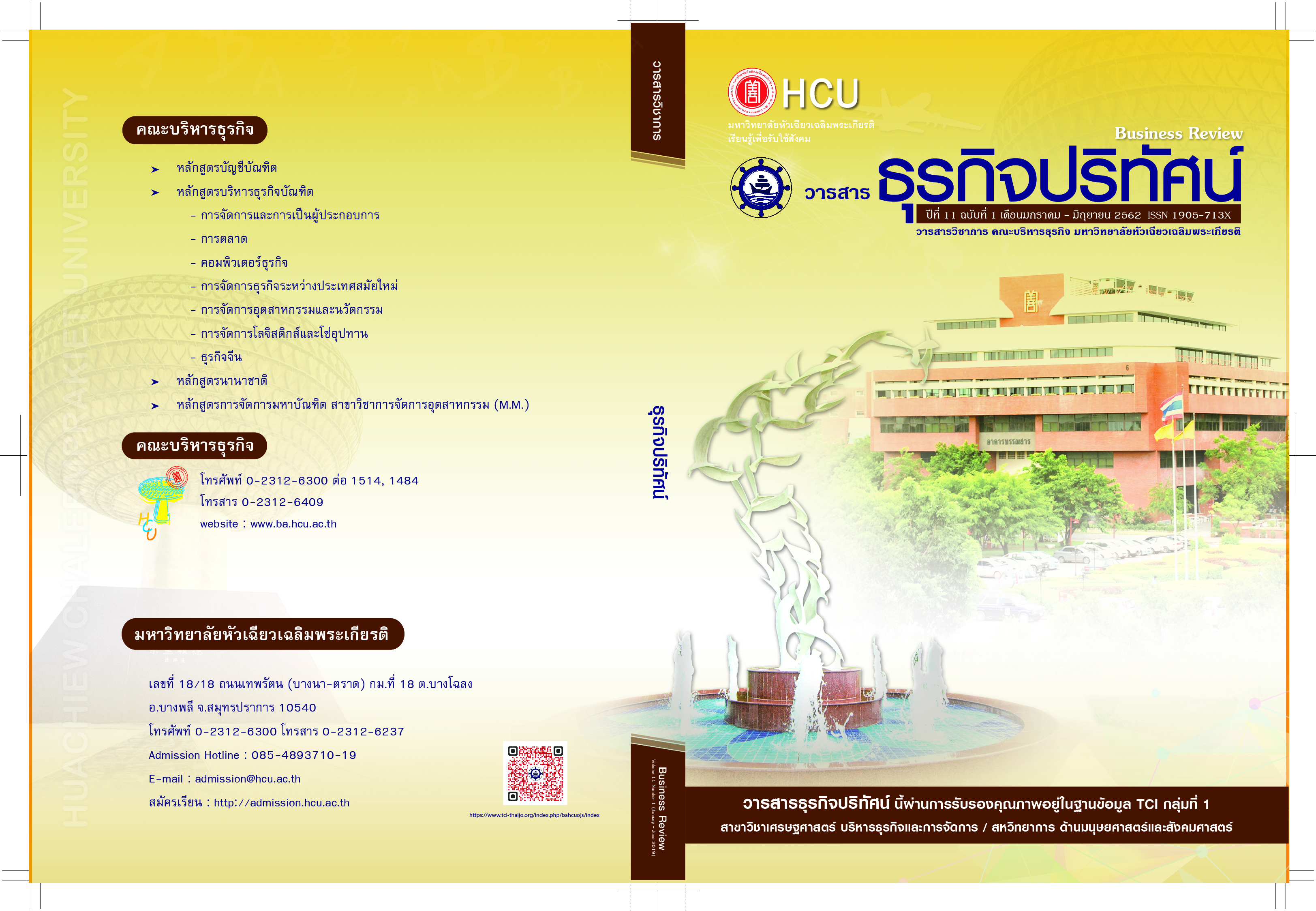Inflf luence of Customer Relationship Management and Entrepreneurial Leadership on the Performance of Eldercare Services Business
Keywords:
customer relationship management, entrepreneurial leadership, elderly care services businessAbstract
The objectives of this research were to: 1) investigate the level of customer relationship
management, entrepreneurial leadership, and performance of elderly care service business; and
2) examine the influence of the customer relationship management, and entrepreneurial leadership
on the performance of elderly care services business. This research employed quantitative methods.
The research sample consisted of 400 elderly care services entrepreneurs in Bangkok and
metropolitan areas. The sample was obtained by systematic sampling. The sample size was
determined based on 10 times the manifest variables. The research instrument was a questionnaire.
Data were analyzed by mean, standard deviation and structure equation model. The result of this
research showed that: 1) the customer relationship management, entrepreneurial leadership
and performance were rated at a high level; and 2) customer relationship management and
entrepreneurial leadership had a direct influence on the performance of elderly care services
business at a .05 level of statistical significance.
References
สืบค้นเมื่อ 15 มกราคม 2561, จาก กรมพัฒนาธุรกิจการค้า กระทรวงพาณิชย์ เว็บไซต์: http://
www.dbd.go.th/mobile/news_view.php?nid=469404775.
กุณฑลี รื่นรมย์. (2547). การมุ่งเน้นลูกค้าและตลาด: สร้างองค์กรให้แตกต่างอย่างเหนือชั้น. กรุงเทพฯ:
อินโนกราฟฟิกส์.
ผู้จัดการออนไลน์. (2560). ธุรกิจบริการผู้สูงอายุโตแรง “พาณิชย์” เร่งสร้างบุคลากรมืออาชีพเข้าท?ำงาน.
สืบค้นเมื่อ 15 มกราคม 2561, จาก ผู้จัดการออนไลน์ เว็บไซต์: https://mgronline.com/smes/
detail/9600000074327.
ลภัสรดา โกมุทพงศ์ และประสพชัย พสุนนท์. (2559). ปัจจัยที่มีผลต่อการสืบทอดกิจการของทายาทธุรกิจ
เพศหญิงในประเทศไทย. วารสารธุรกิจปริทัศน์, 8(1), 103-117.
Assche, T. V. (2005). The impact of entrepreneurial leadership on EU high politics: A case study
of jacques delores and the creation of EMU. Retrieved January 5, 2017, from Syracuse
University, USA Website: http://www. lea.sagepub. com/cgi/ content/ abstract/1/3/279.
Chien, S. (2014). Franchisor resources, spousal resources, entrepreneurial orientation, and performance
in a couple-owned franchise outlet. Management Decision, 52(5), 916-933.
Cho, T. (2011). Knowledge management capabilities and organizational performance: An investigation
into the effects of knowledge infrastructure and processes on organizational performance.
Ph.D. Dissertation, University of Illinois at Urbana-Champaign, USA.
Fernald, L.W., Soloman, G.T., & Tarabishy, A. (2005). A new paradigm: entrepreneurial leadership.
Southern Business Review, 30(2), 1-10.
Fontana, A., & Musa, S. (2017). The impact of entrepreneurial leadership on innovation management
and its measurement validation. International Journal of Innovation Science, 9(1), 2-19.
Frese, M. (2000). Success and failure of micro business owners in Africa. USA: Greenwood
Publishing.
Gray, J.H., Densten, I.L., & Sarros, J.C. (2003). Size matters: organisational culture in small, medium,
and large Australian organizations. Journal of Small Business and Entrepreneurship,
17(1), 31-46.
Gupta, V., MacMillan, I.C., & Surie, G. (2004). Entrepreneurial leadership: developing and
measuring a cross-cultural construct. Journal of Business Venturing, 19(2), 241-260.
Hair, J.F., Black, W.C., Babin, B.J., & Anderson, R.E. (2010). Multivariate data analysis: A global
perspective (7th ed.). Upper Saddle River: Pearson Education.
Hansson, F., & Monsted, M. (2008). Research leadership as entrepreneurial organizing for research.
Higher Education, 55(6), 651-670.
Keramati, A., Mehrabi, H., & Mojir, N. (2010). A process-oriented perspective on customer
relationship management and organizational performance: an empirical investigation.
Industrial Marketing Management, 39(7), 1170-1185.
Kim, H., & Kim, Y. (2009). A CRM performance measurement framework: Its development process
and application. Industrial Marketing Management, 38(4), 477-489.
Lee, M. K. O., & Turban, E. (2001). A trust model for consumer internet shopping. International
Journal of Electronic Commerce, 6 (1), 75-91.
Lin, R.J., Chen, R.H., & Chiu, K.K.S. (2010). Customer relationship management and innovation
capability: an empirical study. Industrial Management & Data Systems, 110(1), 111-133.
Ngai, E. W. T. (2005). Customer relationship management research. An academic literature review
and classification. Journal of Marketing, 39(11/12), 582-605.
Reinartz, W., Krafft, M., & Hoyer, W.D. (2004). The customer relationship management process:
Its measurement and impact on performance. Journal of Marketing Research, 41(3), 293-305.
Roh, T.H., Ahn, C.K., & Han, I. (2005). The priority factor model for customer relationship
management system success. Expert Systems with Applications, 28(4), 641-654.
Ruvio, A., Rosenblatt, Z., & Hertz-Lazarowitz, R. (2010). Entrepreneurial leadership vision in
nonprofit vs for-profit organizations. The Leadership Quarterly, 21(1), 144-158.
Schoder, D., & Madeja, N. (2004). Is customer relationship management a success factor in
electronic commerce?. Journal of Electronic Commerce Research, 5(1), 2004.
Suprapto, B., Wahab, H.A., & Wibowo. A.J. (2009). The implementation of balance score card for
performance measurement in small and medium enterprises: Evidence from Malaysian Health
Care Services. The Asian Journal of Technology Management, 2(2), 37-49
United Nations. (2015). World Population Ageing 2015. Retrieved January 15, 2017, from United
Nations Website: http://www.un.org/en/development/desa/population/publications/pdf/ageing/
WPA2015_Report.pdf.
Valmohammadi, C., & Beladpas, M. (2014). Customer relationship management and service quality:
a survey within the banking sector. Industrial and Commercial Training, 46(2), 77-83.
Downloads
Published
How to Cite
Issue
Section
License
All articles published in the Business Administration and Management Journal Review are copyrighted by the journal.
The views and opinions expressed in each article are solely those of the individual authors and do not represent those of Huachiew Chalermprakiet University or any other faculty members. Each author is fully responsible for the content of their own article. Any errors or issues found are the sole responsibility of the respective author.




